Prevention of depression in adults with long-term physical conditions
- PMID: 33667319
- PMCID: PMC8092431
- DOI: 10.1002/14651858.CD011246.pub2
Prevention of depression in adults with long-term physical conditions
Abstract
Background: Major depression is one of the world's leading causes of disability in adults with long-term physical conditions compared to those without physical illness. This co-morbidity is associated with a negative prognosis in terms of increased morbidity and mortality rates, increased healthcare costs, decreased adherence to treatment regimens, and a substantial decline in quality of life. Therefore, preventing the onset of depressive episodes in adults with long-term physical conditions should be a global healthcare aim. In this review, primary or tertiary (in cases of preventing recurrences in those with a history of depression) prevention are the focus. While primary prevention aims at preventing the onset of depression, tertiary prevention comprises both preventing recurrences and prohibiting relapses. Tertiary prevention aims to address a depressive episode that might still be present, is about to subside, or has recently resolved. We included tertiary prevention in the case where the focus was preventing the onset of depression in those with a history of depression (preventing recurrences) but excluded it if it specifically focused on maintaining an condition or implementing rehabilitation services (relapse prevention). Secondary prevention of depression seeks to prevent the progression of depressive symptoms by early detection and treatment and may therefore be considered a 'treatment,' rather than prevention. We therefore exclude the whole spectrum of secondary prevention.
Objectives: To assess the effectiveness, acceptability and tolerability of psychological or pharmacological interventions, in comparison to control conditions, in preventing depression in adults with long-term physical conditions; either before first ever onset of depressive symptoms (i.e. primary prevention) or before first onset of depressive symptoms in patients with a history of depression (i.e. tertiary prevention).
Search methods: We searched the Cochrane Common Mental Disorders Controlled Trials Register, CENTRAL, MEDLINE, Embase, PsycINFO and two trials registries, up to 6 February 2020.
Selection criteria: We included randomised controlled trials (RCTs) of preventive psychological or pharmacological interventions, specifically targeting incidence of depression in comparison to treatment as usual (TAU), waiting list, attention/psychological placebo, or placebo. Participants had to be age 18 years or older, with at least one long-term physical condition, and no diagnosis of major depression at baseline (primary prevention). In addition, we included studies comprising mixed samples of patients with and without a history of depression, which explored tertiary prevention of recurrent depression. We excluded other tertiary prevention studies. We also excluded secondary preventive interventions. Primary outcomes included incidence of depression, tolerability, and acceptability. Secondary outcomes included severity of depression, cost-effectiveness and cost-utility.
Data collection and analysis: We used standard methodological procedures expected by Cochrane.
Main results: We included 11 RCTs, with one trial on psychological interventions, and 10 trials on pharmacological interventions. Data analyses on the psychological intervention (problem-solving therapy compared to TAU) included 194 participants with age-related macular degeneration. Data analyses on pharmacological interventions included 837 participants comparing citalopram (one trial), escitalopram (three trials), a mixed sample of fluoxetine/nortriptyline (one trial), melatonin (one trial), milnacipran (one trial), and sertraline (three trials), each to placebo. Included types of long-term physical conditions were acute coronary syndrome (one trial), breast cancer (one trial), head and neck cancer (two trials), stroke (five trials), and traumatic brain injury (one trial). Psychological interventions Very low-certainty evidence of one study suggests that problem solving therapy may be slightly more effective than TAU in preventing the incidence of depression, immediately post-intervention (odds ratio (OR) 0.43, 95% confidence interval (CI) 0.20 to 0.95; 194 participants). However, there may be little to no difference between groups at six months follow-up (OR 0.71, 95% CI 0.36 to 1.38; 190 participants; one study; very low-certainty evidence). No data were available regarding incidence of depression after six months. Regarding acceptability (drop-outs due to any cause), slightly fewer drop-outs occurred in the TAU group immediately post-intervention (OR 5.21, 95% CI 1.11 to 24.40; 206 participants; low-certainty evidence). After six months, however, the groups did not differ (OR 1.67, 95% CI 0.58 to 4.77; 206 participants; low-certainty evidence). This study did not measure tolerability. Pharmacological interventions Post-intervention, compared to placebo, antidepressants may be beneficial in preventing depression in adults with different types of long-term physical conditions, but the evidence is very uncertain (OR 0.31, 95% CI 0.20 to 0.49; 814 participants; nine studies; I2 =0%; very low-certainty evidence). There may be little to no difference between groups both immediately and at six months follow-up (OR 0.44, 95% CI 0.08 to 2.46; 23 participants; one study; very low-certainty evidence) as well as at six to 12 months follow-up (OR 0.81, 95% CI 0.23 to 2.82; 233 participants; three studies; I2 = 49%; very low-certainty evidence). There was very low-certainty evidence from five studies regarding the tolerability of the pharmacological intervention. A total of 669 adverse events were observed in 316 participants from the pharmacological intervention group, and 610 adverse events from 311 participants in the placebo group. There was very low-certainty evidence that drop-outs due to adverse events may be less frequent in the placebo group (OR 2.05, 95% CI 1.07 to 3.89; 561 participants; five studies; I2 = 0%). There was also very low-certainty evidence that drop-outs due to any cause may not differ between groups either post-intervention (OR 1.13, 95% CI 0.73 to 1.73; 962 participants; nine studies; I2 = 28%), or at six to 12 months (OR 1.13, 95% CI 0.69 to 1.86; 327 participants; three studies; I2 = 0%).
Authors' conclusions: Based on evidence of very low certainty, our results may indicate the benefit of pharmacological interventions, during or directly after preventive treatment. Few trials examined short-term outcomes up to six months, nor the follow-up effects at six to 12 months, with studies suffering from great numbers of drop-outs and inconclusive results. Generalisation of results is limited as study populations and treatment regimes were very heterogeneous. Based on the results of this review, we conclude that for adults with long-term physical conditions, there is only very uncertain evidence regarding the implementation of any primary preventive interventions (psychological/pharmacological) for depression.
Copyright © 2021 The Cochrane Collaboration. Published by John Wiley & Sons, Ltd.
Conflict of interest statement
HK: None known HB: None known JB: None known OM: None known
Figures
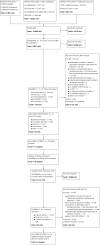
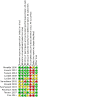

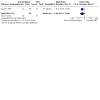
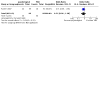
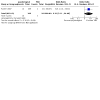
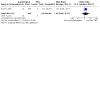
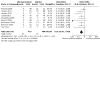
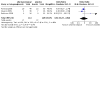
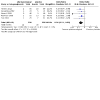

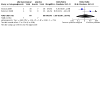
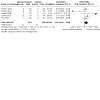
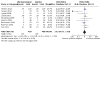
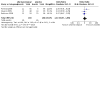
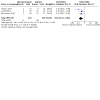
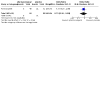
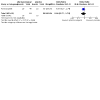
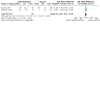

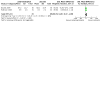
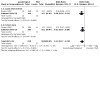
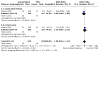

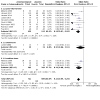
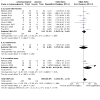
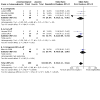
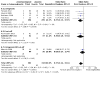
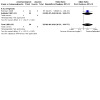


Update of
- doi: 10.1002/14651858.CD011246
References
References to studies included in this review
Almeida 2006 {published data only}
-
- Almeida OP, Waterreus A, Hankey GJ. Preventing depression after stroke: results from a randomized placebo-controlled trial. Journal of Clinical Psychiatry 2006;67(7):1104-9. - PubMed
Hansen 2012 {published data only}
-
- *Hansen BH, Hanash JA, Rasmussen A, Hansen JF, Andersen NL, Nielsen OW, Birekt-Smith M. Effects of escitalopram in prevention of depression in patients with acute coronary syndrome (DECARD). Journal of Psychosomatic Research 2012;72:11-6. - PubMed
-
- Hanash JA, Hansen BH, Hansen JF, Nielsen OW, Rasmussen A, Birket-Smith M. Cardiovascular safety of one-year escitalopram therapy in clinically nondepressed patients with acute coronary syndrome: results from the depression in patients with coronary artery disease (DECARD) trial. Journal of Cardiovascular Pharmacology 2012;60(4):397-405. - PubMed
-
- Hanash JA. Impact of prevention of DEpression in patients with acute coronary syndrome on CARDiac risk profile (DECARD): a double-blind, placebo-controlled study of escitalopram. International Journal of Cardiology 2007;119:14-5.
-
- Hansen B, Hanash J, Rasmussen A, Fischer HJ, Traerup AN, Birket-Smith M. Effects of escitalopram in prevention of depression in patients with acute coronary syndrome (DECARD): randomised controlled trial. Abstracts from the 13th Annual Meeting of the European Association for Consultation-Liaison Psychiatry and Psychosomatics, EACLPP and the 28th European Conference on Psychosomatic Research, ECPR. In: Journal of Psychosomatic Research. Innsbruck, Austria, 2010 Jun 30-July 3.
-
- Hansen B, Hanash J, Rasmussen A, Hansen J, Andersen N, Birket-Smith M. Escitalopram prevents depression in patients with acute coronary syndrome (DECARD): a randomized controlled trial [NCT00140257]. In: European Journal of Cardiovascular Prevention and Rehabilitation [Abstracts from the EuroPRevent 2010 Conference. Prague Czech Republic, May 5-7 2010.
Hansen 2014 {published data only}
-
- *Hansen MV, Andersen LT, Madsen MT, Hageman I, Rasmussen LS, Bokmand S, Rosenberg J, Gögenur I. Effect of melatonin on depressive symptoms and anxiety in patients undergoing breast cancer surgery: a randomized, double-blind, placebo-controlled trial. Breast Cancer Research and Treatment 2014;145:683-95. - PubMed
-
- Hansen MV, Madsen MT, Hageman I, Rasmussen LS, Bokmand S, Rosenberg J, Gögenur I. The effect of MELatOnin on Depression,anxietY, cognitive function and sleep disturbances in patients with breast cancer. The MELODY trial: protocol for a randomised, placebo-controlled, double-blinded trial. BMJ Open 2012;2:e000647. - PMC - PubMed
Lydiatt 2008 {published data only}
-
- *Lydiatt WM, Denman D, McNeilly DP, Puumula SE, Burke WJ. A randomized, placebo-controlled trial of citalopram for the prevention of major depression during treatment for head and neck cancer. Archives of Otolaryngology - Head & Neck Surgery 2008;134(5):528-35. - PubMed
-
- Lazure KE, Lydiatt WM, Denman D, Burke WJ. Association between depression and survival or disease recurrence in patients with head and neck cancer enrolled in a depression prevention trial. Head & Neck 2009;31(7):888-92. - PubMed
Lydiatt 2013 {published data only}
-
- Lydiatt WM, Bessette D, Schmid KK, Sayles H, Burke WJ. Prevention of depression with escitalopram in patients undergoing treatment for head and neck cancer randomized, double-blind, placebo-controlled clinical trial. JAMA Otolaryngology - Head & Neck Surgery 2013;139(7):678-86. - PubMed
Narushima 2002 {published data only}
-
- Narushima K, Kosier TJ, Robinson RG. Preventing poststroke depression: a 12-week double-blind randomized treatment trial and 21-month follow-up. Journal of Nervous and Mental Disease 2002;190(5):296-303. - PubMed
Novack 2009 {published data only}
-
- Novack TA, Baños JH, Brunner R, Renfroe S, Meythaler JM. Impact of early administration of sertraline on depressive symptoms in the first year after traumatic brain injury. Journal of Neurotrauma 2009;26:1921-8. - PubMed
Rasmussen 2003 {published data only}
-
- *Rasmussen A, Lunde M, Poulsen DL, Sörensen K, Qvitzau S, Bech P. A double-blind, placebo-controlled study of sertraline in the prevention of depression in stroke patients. Psychosomatics 2003;44(3):216-21. - PubMed
-
- Rasmussen A, Lunde M, Poulsen DL, Sörensen K, Qvitzau S, Bech P. A double-blind, placebo-controlled study of sertraline in the prevention of depression in stroke patients - correction. Psychosomatics 2004;45(1):91. - PubMed
Robinson 2008 {published data only}
-
- Robinson RG, Arndt S. Escitalopramand problem-solving therapy for prevention of poststroke depression: a randomized controlled trial - correction. JAMA 2009;301(10):1023-4. - PubMed
-
- Robinson RG, Jorge RE, Long J. Prevention of poststroke mortality using problem-solving therapy or escitalopram. American Journal of Geriatric Psychiatry 2017;25:512-9. - PubMed
Rovner 2007 {published data only}
-
- *Rovner Barry W, Casten Robin J, Hegel Mark T, Leiby Benjamin E, Tasman William S. Preventing depression in age-related macular degeneration. Archives of General Psychiatry 2007;64(8):886-92. - PubMed
Tsai 2011 {published data only}
-
- Tsai C-S, Wu C-L, Chou S-Y, Tsang H-Y, Hung T-H, Su J-A. Prevention of poststroke depression with milnacipran in patients with acute ischemic stroke: a double-blind randomized placebo-controlled trial. International Clinical Psychopharmacology 2011;26:263-7. - PubMed
References to studies excluded from this review
Almeida 2010 {published data only}
-
- Almeida OP, Marsh K, Alfonso H, Flicker L, Davis TME, Hankey GJ. B-vitamins reduce the long-term risk of depression after stroke:the VITATOPS-DEP Trial. Annals of Neurology 2010;68:503-10. - PubMed
Beglinger 2014 {published data only}
Borrelli 2019 {published data only}
-
- Borrelli J Jr, Starr A, Downs DL, North CS. Prospective Study of the Effectiveness of Paroxetine on the Onset of Posttraumatic Stress Disorder, Depression, and Health and Functional Outcomes After Trauma. Journal of Orthopaedic Trauma 2019;33(2):e58-e63. - PubMed
Brody 2005 {published data only}
-
- Brody BL, Roch-Levecq A-C, Thomas RG, Kaplan RM, Brown SI. Self-management of age-related macular degeneration at the 6-month follow-up. Archives of ophthalmology 2005;123:46-53. - PubMed
Browne 2013 {published data only}
-
- Browne AL, Appleton S, Fong K, Wood F, Coll F, Munck S, et al. A pilot randomized controlled trial of an early multidisciplinary model to prevent disability following traumatic injury. Disability & Rehabilitation 2013;35(14-15):1149-63. - PubMed
Burns 2007 {published data only}
-
- Burns A, Banerjee S, Morris J, Woodward Y, Baldwin R, Proctor R, et al. Treatment and prevention of depression after surgery for hip fracture in older people: randomized, controlled trials. Journal of the American Geriatrics Society 2007;55(1):75-80. - PubMed
Couch 1976 {published data only}
-
- Couch JR, Hassanein RS. Migraine and depression: effect of amitriptyline prophylaxis. Transactions of the American Neurological Association 1976;101:234-7. - PubMed
Dean 1969 {published data only}
-
- Dean G. A double-blind trial with an antidepressant drug, imipramine, in multiple sclerosis. South African Medical Journal 1969;43(4):86-7. - PubMed
de Jonge 2009 {published data only (unpublished sought but not used)}
-
- Jonge P, Hadj FB, Boffa D Zdrojewski C, Dorogi Y, So A, et al. Prevention of major depression in complex medically ill patients: preliminary results from a randomized, controlled trial. Psychosomatics 2009;50(3):227-33. - PubMed
-
- Stiefel F, Zdrojewski C, Bel Hadj F, Boffa D, Dorogi Y, So A, et al. Eligible patients were included and, if identified as complex, randomized to the intervention or care as usual by means of a computer-generated list. Psychotherapy and Psychosomatics 2008;77:247-56. - PubMed
Hackett 2010 {published data only}
-
- Hackett ML, Carter G, Crimmims D, Clarke T, Maddock K, Sturm JW. ImProving Outcomes after STroke clinical pilot trial protocol. International Journal of Stroke 2010;5:52-6. - PubMed
Hackett 2013 {published data only}
-
- Hackett ML, Carter G, Crimmins D, Clarke T, Arblaster L, Billot L, et al. ImPrOving outcomes after STroke (POST): results from the randomized clinical pilot trial. International Journal of Stroke 2013;8:707-10. - PubMed
Hood 2018 {published data only}
Karp 2016 {published data only}
-
- Karp JF, Dew MA, Washed AS, Fitzgerald K, Bolon CA, Weiner DK, et al. Challenges and solutions for depression prevention research: methodology for a depression prevention trial for older adults with knee arthritis and emotional distress. American Journal Geriatric Psychiatry 2016;24(6):433-43. - PMC - PubMed
Kong 2007 {published data only}
-
- Kong Y, Dong W, Liu C. Fluoxetine for poststroke depression: A randomized placebo controlled clinical trial. Neural Regeneration Research 2007;2(3):162-5.
Kredentser 2018 {published data only}
-
- Kredentser MS, Blouw M, Marten N, Sareen J, Bienvenu OJ, Ryu J, Beatie BE, Logsetty S, Graff LA, Eggertson S, Sweatman S, Debroni B, Cianflone N, Arora RC, Zarychanski R, Olafson K. Preventing Posttraumatic Stress in ICU Survivors: A Single-Center Pilot Randomized Controlled Trial of ICU Diaries and Psychoeducation. Critical Care Medicine 2018;46(12):1914-22. - PubMed
Mossey 1996 {published data only}
-
- Mossey JM, Knott KA, Higgins M, Talerico K. Effectiveness of a psychosocial intervention, interpersonal counseling, for subdysthymic depression in medically ill elderly. Journal of Gerontology 1996;51A(4):172-8. - PubMed
Niedermaier 2004 {published data only}
-
- Niedermaier N, Bohrer E, Schulte K, Schlattmann P, Heuser I. Prevention and treatment of poststroke depression with mirtazapine in patients with acute stroke. Journal of Clinical Psychiatry 2004;65(12):1619-23. - PubMed
Pitceathly 2009 {published data only}
-
- Pitceathly C, Maguire P, Fletcher I, Parle M, Tomenson B, Creed F. Can a brief psychological intervention prevent anxiety or depressive disorders in cancer patients? A randomised controlled trial. Annals of Oncology 2009;20:928-34. - PubMed
Pols 2017 {published data only}
-
- *Pols AD, Dijk SE, Bosmans JE, Hoekstra T, Marwijk HW, Tulder MW, et al. Effectiveness of a stepped-care intervention to prevent major depression in patients with type 2 diabetes mellitus and/or coronary heart disease and subthreshold depression: a pragmatic cluster randomized controlled trial. PLOS One 2017;12(8):1-15. - PMC - PubMed
-
- Dijk SE, Pols AD, Adriaanse MC, Bosmans JE, Elders PJ, Marwijk HW, et al. Cost-effectiveness of a stepped-care intervention to prevent major depression in patients with type2 diabetes mellitus and/or coronary heart disease and subthreshold depression: design of a cluster-randomized controlled trial. BMC Psychiatry 2013;13:128. - PMC - PubMed
Read 2020 {published data only}
-
- Read J, Sharpe L, Burton AL, Arean PA, Raue PJ, McDonald S, Titov N, Gandy M, Dear BF. A randomized controlled trial of internet-delivered cognitive behaviour therapy to prevent the development of depressive disorders in older adults with multimorbidity. Journal of Affective Disorders 2020;264:464-3. - PubMed
Rovner 2014 {published data only}
van der Aa 2015 {published data only}
-
- Corrections. Stepped care for depression and anxiety in visually impaired older adults: multicentre randomised controlled trial. BMJ 2016;353:i1995. [DOI: ] - PubMed
Yeung 2014 {published data only}
-
- Yeung A, Kiat H, Denniss AR, Cheema BS, Bensoussan A, Machliss B, et al. Randomised controlled trial of a 12 week yoga intervention on negative affective states, cardiovascular and cognitive function in post-cardiac rehabilitation patients. BMC Complementary and Alternative Medicine 2014;14:411. - PMC - PubMed
Zhang 2013 {published data only}
-
- Zhang L-S, Hu X-Y, Yao L-Y, Geng Y, Wei l-L, Zhang J-H, et al. Prophylactic effects of duloxetine on post-stroke depression symptoms: an open single-blind trial. European Neurology 2013;69:336-43. - PubMed
References to studies awaiting assessment
ChiCTR‐TRC‐12003489 {unpublished data only}
-
- ChiCTR-TRC-12003489. Early intervention and prevention with acupuncture therapy on the post stroke depression: A randomized controlled clinical trial [针刺疗法早期预防中风后抑郁的随机对照试验]. chictr.org.cn/hvshowproject.aspx?id=6651 2012.
EudraCT‐2005‐005266‐37 {published data only}
-
- EudraCT-2005-005266-37. Influence of escitalopram on the incidence of depression and dementia following acute middle cerebral artery territory infarction. A randomized, placebo-controlled, double blind study. clinicaltrialsregister.eu/ctr-search/trial/2005-005266-37/DE (first received 1 April 2006).
Guneri 2006 {published data only}
-
- Guneri A, Gursoy E, Celebi A, Arslan E, Vardar N, Kaya S. The effects of antidepressant prophylaxis on prognosis of non-depressed acute stroke patients. Journal of Neurology 2006;253:162.
He 2004 {published data only}
-
- He P, Kong Y, Xu L-Z. Randomized controlled observation on the effect of early application of fluoxetine in preventing depression after stroke. Chinese Journal of Clinical Rehabilitation 2004;8(28):6016-7.
Li 2004 {published data only}
-
- Li J, He QY, Han MF. Recent effect of fluoxetine in improving neurologic impairment and preventing post-stroke depression in the early stage. Chinese Journal of Clinical Rehabilitation 2004;8:1208-9.
Lu 2010 {published data only}
-
- Lu R, Miao D, Wang H, Tan L. Prophylactic small dose amitriptyline in prevention of poststroke depression in first stroke patients [早期应用小剂量阿米替林干预首发脑卒中患者脑卒中后抑郁]. Chinese Journal of Neurology 2010;43(5):355-7.
Sander 2017 {unpublished data only}
-
- Sander L, Paganini S, Lin J, Schlicker S, Ebert DD, Buntrock C, et al. Effectiveness and cost-effectiveness of a guided internet- and mobile-based intervention for the indicated prevention of major depression in patients with chronic back pain—study protocol of the PROD-BP multicenter pragmatic RCT. BMC Psychiatry 2017;17(1):36. - PMC - PubMed
van Zyl 2006 {published data only}
-
- Zyl LT, Abdollah H, Parker K. Antidepressant prevention of depression and cardiovascular sequelae post-acute coronary syndrome: The 'AVERT' trial. Conference Paper 2006.
Wen 2006 {published data only}
-
- Wen Z, Li H. The influence of post-stroke prophylactic antidepression treatment on nerve functional rehabilitation. Acta Aacademiae Medical Quingdao Universitatis 2006;12:253-4.
Xu 2006 {published data only}
-
- Xu J, Wang JP, Liu J. Preventive effects of antidepressants on post-stroke depression [抗抑郁剂在脑卒中患者中的预防性应用]. Chinese Mental Health Journal 2006;20:186-8.
Zhong 2013 {published data only}
-
- Zhong Y. Preliminary study on effect of venlafaxine sustained-release tablet combined with pinaverium bromide in treating diarrhea-predominant irritable bowel syndrome without mood disorders. Chinese Journal of Gastroenterology 2013;18(11):658-62.
Zhou 2008 {published data only}
-
- Zhou Z, Liang L, Yan Y. Preventive Effects of Fluoxetine on Post-stroke Depression. Chinese Journal of Modern Applied Pharmacy 2008;25:262-4.
Zhu 2014 {published data only}
-
- Zhu J, Hu CM, Guo SS, Wang F, Zhou Y, Zhang SY. Wuling capsule played an assistant role in primary prevention of post-stroke depression: a clinical research [乌灵胶囊辅助治疗对卒中后抑郁一级预防作用的临床观察]. Chinese Journal of Integrated Traditional and Western Medicine 2014;34(6):676-9. - PubMed
References to ongoing studies
ACTRN12616000886482 {unpublished data only}
-
- ACTRN12616000886482. Randomised trial aiming to prevent development of depression and improve quality of life in individuals with dementia (Alzheimer’s disease) [Randomised trial aiming to prevent development of depression and improve quality of life in individuals with dementia (Alzheimer’s disease) through a novel Cognitive Bias Modification intervention]. anzctr.org.au/Trial/Registration/TrialReview.aspx?id=371029 (first received 4 July 2016).
Madsen 2017 {unpublished data only}
-
- Madsen MT, Isbrand A, Andersen UO, Andersen LJ, Taskiran M, Simonsen E, Gögenur I. The effect of MElatonin on Depressivesymptoms, Anxiety, CIrcadian and Sleepdisturbances in patients after acute coronary syndrome (MEDACIS): study protocol for a randomized controlled trial. Trials 2017;18(1):81. [DOI: 10.1186/s13063-017-1806-x] - DOI - PMC - PubMed
Additional references
AHRQ 2012
-
- Agency for Healthcare Research and Quality (AHRQ), RTI International–University of North Carolina Evidence-based Practice Center. Practice-based interventions addressing concomitant depression and chronic medical conditions in the primary care setting: Comparative effectiveness review no. 75 (prepared by the RTI international–university of North Carolina evidence-based practice center under contract No. 290-2007-10056-I). AHRQ publication no. 12-EHC106-EF. Rockville, MD: agency for healthcare research and quality. August 2012. Available from http://effectivehealthcare.ahrq.gov/ehc/products/297/1219/CER75_Concomit.... - PubMed
Akechi 2008
APA 1980
-
- American Psychiatric Association. Diagnostic and statistical manual of mental disorders (DSM-III). 3rd edition. Washington, DC: American Psychiatric Association, 1980.
APA 1987
-
- American Psychiatric Association. Diagnostic and statistical manual of mental disorders (DSM-III-R). 3rd edition - revised. Washington, DC: American Psychiatric Association, 1987.
APA 1994
-
- American Psychiatric Association. Diagnostic and statistical manual of mental disorders (DSM-IV). 4th edition. Washington, DC: American Psychiatric Association, 1994.
APA 2000
-
- American Psychiatric Association. Diagnostic and statistical manual of mental disorders (DSM-IV-TR). 4th edition. Washington, DC: American Psychiatric Association, 2000.
APA 2013
-
- American Psychiatric Association. Diagnostic and statistical manual of mental disorders (DSM-5). 5th edition. Arlington, Va: American Psychiatric Association, 2013.
Arroll 2009
Baumeister 2007
-
- Baumeister H, Härter M. Prevalence of mental disorders based on general population surveys. Social Psychiatry and Psychiatric Epidemiology 2007;42(7):537-46. - PubMed
Baumeister 2011a
-
- Baumeister H, Hutter N, Bengel J, Härter M. Quality of life in medically ill persons with comorbid mental disorders: a systematic review and meta-analysis. Psychotherapy and Psychosomatics 2011;80(12):275-86. - PubMed
Baumeister 2011b
Baumeister 2012a
-
- Baumeister H, Knecht A, Hutter N. Direct and indirect costs in persons with chronic back pain and comorbid mental disorders - A systematic review. Journal of Psychosomatic Research 2012;73(2):79-85. - PubMed
Baumeister 2012b
-
- Baumeister H, Parker G. Meta-review of depressive subtyping models. Journal of Affective Disorders 2012;139:126-40. - PubMed
Baumeister 2012c
Bech 2001
-
- Bech P, Rasmussen NA, Olsen LR, Noerholm V, Abildgaard W. The sensitivity and specificity of the Major Depression Inventory, using the Present State Examination as the index of diagnostic validity. Journal of Affective Disorders 2001;66(2-3):159-64. - PubMed
Beck 1961
-
- Beck AT, Ward CH, Mendelson M, Mock J, Erbaugh J. An inventory for measuring depression. Archives of General Psychiatry 1961;4:561-71. - PubMed
Beltman 2010
-
- Beltman MW, Oude Voshaar RC, Speckens AE. Cognitive-behavioural therapy for depression in people with a somatic disease: meta-analysis of randomised controlled trials. British Journal of Psychiatry 2010;197:11-19. - PubMed
Cipriani 2009
Cipriani 2012
Clarke 2009
-
- Clarke DM, Currie KC. Depression, anxiety and their relationship with chronic diseases: a review of the epidemiology, risk and treatment evidence. Medical Journal of Australia 2009;190(7):54-60. - PubMed
Cuijpers 2008
-
- Cuijpers P, Straten A, Smit F, Mihalopoulos C, Beekman A. Preventing the onset of depressive disorders: a meta-analytic review of psychological interventions. American Journal of Psychiatry 2008;165(10):1272-80. - PubMed
de Geus 2006
-
- Geus EJ. Genetic pleiotropy in depression and coronary artery disease. Psychosomatic Medicine 2006;68(2):185-6. - PubMed
DGPPN 2012
-
- DGPPN, BÄK, KBV, AWMF, AkdÄ, BPtK, et al. S3-Leitlinie/Nationale VersorgungsLeitlinie Unipolare Depression Langfassung. Version 1.3, Januar 2012. Available from http://www.versorgungsleitlinien.de/themen/depression/pdf/s3_nvl_depress....
Durand 2012
-
- Durand VM, Barlow DH. An integrative approach to psychopathology. In: Essentials of Abnormal Psychology. 6th edition. Cengage Learning Emea, 2012:30-68.
Endicott 1978
-
- Endicott J, Spitzer RL. A diagnostic interview: the schedule for affective disorders and schizophrenia. Archives in General Psychiatry 1978;35(7):837-44. - PubMed
Evans 2005
-
- Evans DL, Charney DS, Lewis L, Golden RN, Gorman JM, Krishnan KR, et al. Mood disorders in the medically ill: scientific review and recommendations. Biological Psychiatry 2005;58(3):175-89. - PubMed
First 1996
-
- First MB, Spitzer RL, Gibbon M, Williams JBW. Structured clinical interview for DSM-IV axis I disorders, clinician version (SCID-CV). Washington, DC: American Psychiatric Press, Inc., 1996.
Freedland 2010
-
- Freedland KE, Carney RM. Depression and medical illness. In: Gotlib IA, Hammen CL, editors(s). Handbook of Depression. 2nd edition. New York: The Guilford Press, 2010:113-41.
Gill 2000
Gordon 1983
GRADEpro GDT [Computer program]
-
- McMaster University (developed by Evidence Prime, Inc.) GRADEpro Guideline Development Tool. Hamilton (ON): McMaster University (developed by Evidence Prime, Inc.), 2020. Available at gradepro.org.
Gunn 2012
-
- Gunn JM, Ayton DR, Densley K, Pallant JF, Chondros P, Herrman HE, et al. The association between chronic illness, multimorbidity and depressive symptoms in an Australian primary care cohort. Social Psychiatry and Psychiatric Epidemiology 2012;47(2):175-84. - PubMed
Guyatt 2011
-
- Guyatt GH, Oxman AD, Montori V, Vist G, Kunz R, Brozek J, et al. GRADE guidelines: 5. rating the quality of evidenced - publication bias. Journal of Clinical Epidemiology 2011;64(12):1277-82. - PubMed
Hackett 2008a
Hackett 2008b
Hamilton 1960
Harmer 2017
Härter 2007a
-
- Härter M, Baumeister H, Reuter K, Jacobi F, Höfler M, Bengel J, et al. Increased 12-month prevalence rates of mental disorders in patients with chronic somatic diseases. Psyhotherapy and Psychosomatics 2007;76(6):354-60. - PubMed
Härter 2007b
-
- Härter M, Baumeister H, Bengel J. Etiology of mental disorders in the chronic physically ill [Ätiologie psychischer Störungen bei chronischen körperlichen Erkrankungen]. In: Psychische Störungen bei körperlichen Erkrankungen. Heidelberg: Springer, 2007:2-11.
Haschke 2012
-
- Haschke A, Hutter N, Baumeister H. Indirect costs in patients with coronary artery disease and mental disorders: a systematic review and meta-analysis. International Journal of Occupational Medicine and Enviroment Health 2012;4:319-29. - PubMed
Herzog 2019
Higgins 2003
Higgins 2011
-
- Higgins JPT, Green S (editors). Cochrane Handbook for Systematic Reviews of Interventions Version 5.1.0 [updated March 2011]. The Cochrane Collaboration, 2011. Available from www.cochrane-handbook.org.
Holahan 2010
-
- Holahan CJ, Pahl SA, Cronkite RC, Holahan CK, North RJ, Moos RH. Depression and vulnerability to incident physical illness across 10 years. Journal of Affective Disorders 2010;123(1-3):222-9. - PubMed
Hutter 2010
-
- Hutter N, Schnurr A, Baumeister H. Healthcare costs in patients with diabetes mellitus and comorbid mental disorders - a systematic review. Diabetologia 2010;53:2470-9. - PubMed
Hutter 2011
-
- Hutter N, Knecht A, Baumeister H. Health care costs in persons with asthma and comorbid mental disorders: A systematic review. General Hospital Psychiatry 2011;33:443-53. - PubMed
Katon 2002
-
- Katon W, Ciechanowski P. Impact of major depression in chronic medical illness. Journal of Psychosomatic Research 2002;53:859-63. - PubMed
Katon 2003
-
- Katon WJ. Clinical and health services relationships between major depression, depressive symptoms, and general medical illness. Biological Psychiatry 2003;54(3):216-26. - PubMed
Katon 2007
-
- Katon W, Lin EH, Kroenke K. The association of depression and anxiety with medical symptom burden in patients with chronic medical illness. General Hospital Psychiatry 2007;29:147-55. - PubMed
Kessler 2003
-
- Kessler RC, Berglund P, Demler O, Jin R, Koretz D, Merikangas KR, et al. The epidemiology of major depressive disorder: results from the National Comorbidity Survey Replication (NCS-R). JAMA 2003;289(23):3095-105. - PubMed
Klatte 2018
Krishnan 2005
-
- Krishnan KR. Treatment of depression in the medically ill. Journal of Clinical Psychopharmacology 2005;25(1):14-8. - PubMed
Kroenke 2001
Lefebvre 2008
-
- Lefebvre C, Eisinga A, McDonald S, Paul N. Enhancing access to reports of randomized trials published world-wide – the contribution of EMBASE records to the CochraneCentral Register of Controlled Trials (CENTRAL) in The CochraneLibrary. Emerging Themes in Epidemiology 2008;5:13. [DOI: 10.1186/1742-7622-5-13] - DOI - PMC - PubMed
McAuley 2000
-
- McAuley L, Pham B, Tugwel P, Moher D. Does the inclusion of grey literature influence estimates of intervention effectiveness reported in meta-analyses? Lancet 2000;356(9237):1228-31. - PubMed
McCaffery 2006
-
- McCaffery JM, Frasure-Smith N, Dubé M-P, Théroux P, Rouleau GA, Duan Q, et al. Common genetic vulnerability to depressive symptoms and coronary artery disease: a review and development of candidate genes related to inflammation and serotonin. Psychosomatic Medicine 2006;68:187-200. - PubMed
Montgomery 1979
-
- Montgomery SA. A new depression scale designed to be sensitive to change. British Journal of Psychiatry 1979;134:382-9. - PubMed
Mrazek 1994
-
- Mrazek PJ, Haggerty RJ. Reducing risks for mental disorders: Frontiers for preventive intervention research. Washington DC: National Academy Press, 1994. - PubMed
Muñoz 1996
-
- Muñoz RF, Mrazek PJ, Haggerty RJ. Institute of medicine report on prevention of mental disorders. Summary and commentary. American Psychologist 1996;51(11):1116-22. - PubMed
Natale 2019
NICE 2009
-
- National Institute for Health and Care Excellence. Depression in adults with a chronic physical health problem: Treatment and management. NICE guidelines [CG91]. October 2009. Available from http://www.nice.org.uk/guidance/CG91. - PubMed
O'Connell 2009
-
- O'Connell ME, Boat T, Warner KE. Preventing mental, emotional, and behavioral disorders among young people. Progress and possibilities. Washington DC: The National Academies Press, 2009. - PubMed
Ostuzzi 2018
Patten 2001
-
- Patten SB. Long-term medical conditions and major depression in a Canadian population study at waves 1 and 2. Journal of Affective Disorders 2001;63(1-3):35-41. - PubMed
Radloff 1977
-
- Radloff LS. The CES-D Scale: A self-report depression scale for research in the general population. Applied Psychological Measurement 1977;1(3):385-401.
Raison 2005
Rayner 2010
Review Manager 2014 [Computer program]
-
- The Nordic Cochrane Centre, The Cochrane Collaboration Review Manager (RevMan). Version 5.3. Copenhagen: The Nordic Cochrane Centre, The Cochrane Collaboration, 2014.
Richards 2017
Rush 2003
-
- Rush AJ, Trivedi MH, Ibrahim HM, Carmody TJ, Arnow B, Klein DN, Markowitz JC, Ninan PT, Kornstein S, Manber R, Thase ME, Kocsis JH, Keller MB. The 16-Item Quick Inventory of Depressive Symptomatology (QIDS), clinician rating (QIDS-C), and self-report (QIDS-SR): a psychometric evaluation in patients with chronic major depression. Biological Psychiatry 2003;54(5):573-83. - PubMed
Schünemann 2013
-
- Schünemann H, Brożek J, Guyatt G, Oxman A, editors. GRADE handbook for grading quality of evidence and strength of recommendations. Updated October 2013. The GRADE Working Group, 2013.
Sheehan 1998
-
- Sheehan DV, Lecrubier Y, Sheehan KH, Amorim P, Janavs J, Weiller E, et al. The Mini-International Neuropsychiatric Interview (M.I.N.I.): the development and validation of a structured diagnostic psychiatric interview for DSM-IV and ICD-10. Journal of Clinical Psychiatry 1998;59 Suppl 20:22-33. - PubMed
Shinohara 2013
Simon 2005
-
- Simon GE, Korff M, Lin E. Clinical and functional outcomes of depression treatment in patients with and without chronic medical illness. Psychological Medicine 2005;35:271-9. - PubMed
Stockton 2004
-
- Stockton P, Gonzales JJ, Stern NP, Epstein SA. Treatment patterns and outcomes of depressed medically ill and non-medically ill patients in community psychiatric practice. General Hospital Psychiatry 2004;26:2-8. - PubMed
Thomas 2006
van Marvijk 2012
Whalley 2011
WHO 1978
-
- World Health Organization. The ninth revision of the international classification of diseases and related health problems (ICD-9). Geneva: World Health Organization, 1978.
WHO 1990
-
- World Health Organization. Composite international diagnostic interview. Geneva: World Health Organization, 1990.
WHO 1992
-
- World Health Organization. ICD-10 classification of mental and behavioural disorders. Available from http://www.who.int/substance_abuse/terminology/icd_10/en/.
WHO 2007
-
- World Health Organization. World health statistics. 2007. Available from http://www.who.int/gho/publications/world_health_statistics/en/.
WHO 2008
-
- World Health Organization. Part 4 - Burden of disease: DALYs. The global burden of disease: 2004 update. 2008. Available from http://www.who.int/healthinfo/global_burden_disease/2004_report_update/en/.
WHO 2016
-
- World Health Organization. Preventing depression in the WHO European Region. 2016. Available from http://www.ncbi.nlm.nih.gov/books/NBK304267/.
Wichers 2005
-
- Wichers MC, Koek GH, Robaeys G, Praamstra AJ, Maes M. Early increase in vegetative symptoms predicts IFN-α-induced cognitive-depressive changes. Psychological Medicine 2005;35:433-41. - PubMed
Wing 1974
-
- Wing JK, Cooper JE, Sartorius N. The measurement and classification of psychiatric symptoms: An instructional manual for the PSE and CATEGO programs. New York: CambridgeUniversity Press, 1974.
Wing 1990
-
- Wing JK, Babor T, Brugha T, Burke J, Cooper JE, Giel R, et al. SCAN. Schedules for Clinical Assessment in Neuropsychiatry. Archives of General Psychiatry 1990;47(6):589-93. - PubMed
Wittchen 2010
-
- Wittchen HU, Jacobi F, Klose M, Ryl L. Gesundheitsberichterstattung des Bundes - Depressive Erkrankungen - Heft 51. Berlin: Robert Koch Institut, 2010.
Zigmond 1983
-
- Zigmond AS, Snaith RP. The hospital anxiety and depression scale. Acta Psychiatrica Scandinavica 1983;67(6):361-70. - PubMed
Publication types
MeSH terms
Substances
LinkOut - more resources
Full Text Sources
Other Literature Sources
Medical

